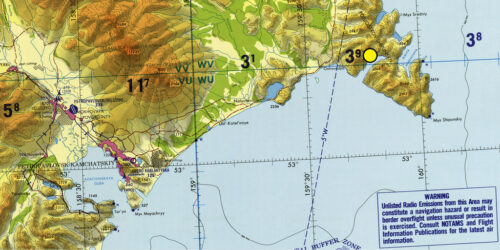View of USS Halibut departing San Francisco, likely in the mid 1970s. U.S. Navy photo.
Operation Ivy Bells was a top-secret mission during the Cold War, jointly executed by the U.S. Navy, the Central Intelligence Agency (CIA), and the National Security Agency (NSA). The objective of this operation was to place wiretaps on Soviet underwater communication lines. This daring and dangerous mission was carried out to gather intelligence about Soviet submarine and missile technology, specifically Intercontinental Ballistic Missile (ICBM) test and nuclear first strike capability.
Background
In the early 1970s, the U.S. government learned of the existence of an undersea communications cable in the Sea of Okhotsk, which connected the major Soviet Pacific Fleet naval base at Petropavlovsk on the Kamchatka Peninsula to the Soviet Pacific Fleet’s mainland headquarters at Vladivostok. At the time, the Sea of Okhotsk was claimed by the Soviet Union as territorial waters and was strictly off limits to foreign vessels. The Soviet Navy had installed a network of sound detection devices along the seabed to detect intruders.

The Mission
Given the complexity of the mission and the technology available at the time, Operation Ivy Bells encountered numerous technical challenges. One of the first obstacles was locating the undersea communication cable and devising a method to tap into it. The cable was situated deep underwater and in close proximity to Russia’s coast, making it difficult to access.
Another hurdle was securing funding for the operation. To finance Operation Ivy Bells, funds were redirected from the U.S. Navy’s deep-submergence rescue vehicle (DSRV) program. The operation also required divers to remain at a depth of 400 feet for several hours to install a wiretap on the cable. Given the pressure and temperature conditions at such depths, this posed a significant challenge. The solution was to use helium for saturation diving.
Despite these obstacles, the potential for an intelligence coup was considered too great to ignore. In October 1971, the U.S. sent the purpose-modified submarine USS Halibut deep into the Sea of Okhotsk. U.S. Navy divers working from Halibut found the cable in 400 feet (120 m) of water and installed a 20-foot (6.1 m) long device, which wrapped around the cable without piercing its casing and recorded all communications made over it. The large recording device was designed to detach if the cable was raised for repair.
The tapping of the Soviet naval cable was so secret that most sailors involved did not have the security clearance needed to know about it. A cover story was thus created to disguise the actual mission: it was claimed that the spy submarines were sent to the Soviet naval range in the Sea of Okhotsk to recover the Soviet SS-N-12 Sandbox supersonic anti-ship missile (AShM) debris so that countermeasures could be developed.
A major technological problem wasn’t extracting the signal from the cable, but rather separating the channels so that the information could be understood. The single cable possibly carried up to a dozen different lines, all filled with Soviet voices chattering away.
Impact and Compromise
The wiretaps placed on Soviet undersea communication lines, gave the U.S. unencrypted information on Russian nuclear strike capabilities, which ultimately led to the completion of the SALT II Treaty and indirectly had a hand in ending the Cold War.
The U.S. continued their operations undetected until 1981, when one day, surveillance satellites showed a number of Soviet warships, including a salvage ship, anchored over the undersea cable. After a long probe, U.S. counterintelligence agents determined an NSA employee, Ronald Pelton, betrayed Operation Ivy Bells to the Soviets. He sold the secret of Operation Ivy Bells for $35,000, which ended nearly a decade of espionage. Pelton was later convicted and sentenced to life in prison.

Conclusion
Operation Ivy Bells was a remarkable feat of Cold War espionage. It showcased the lengths to which nations would go to gather intelligence on their adversaries. Despite its eventual compromise, the operation provided the U.S. with invaluable insights into Soviet capabilities and intentions, contributing significantly to the strategic balance during a critical period of the Cold War.
Resources
Central Intelligence Agency
CIA.gov
National Security Agency
NSA.gov
U.S. Navy
Navy.mil
*The views and opinions expressed on this website are solely those of the original authors and contributors. These views and opinions do not necessarily represent those of Spotter Up Magazine, the administrative staff, and/or any/all contributors to this site.
